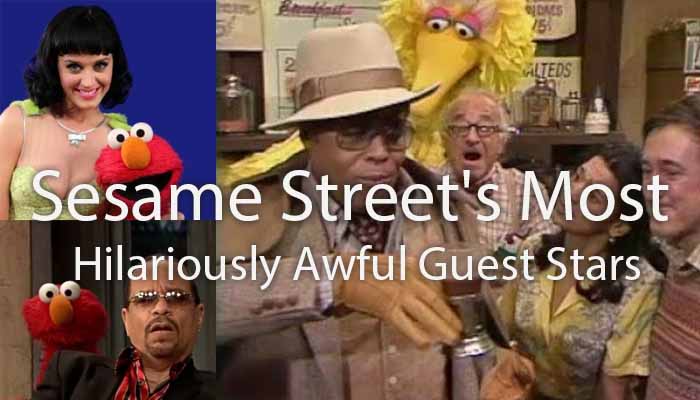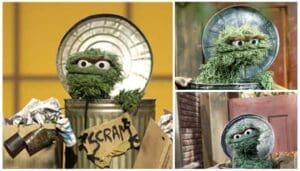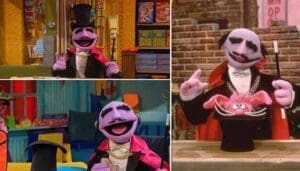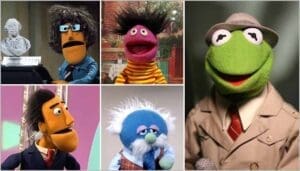Ah, Sesame Street. That magical place where sunny days chase the clouds away, where friendly monsters teach us our ABCs and 123s, and where it’s not only okay to love cookies, but it’s practically a prerequisite for citizenship. For over half a century, this beloved program has been an educational bedrock, a cultural touchstone, and a beacon of childhood innocence. It’s where we learned that everyone makes mistakes, and that’s okay.
But folks, even on the most carefully planned neighborhood block party, sometimes a guest shows up who makes you (or your parents, or the network executives) go, “Wait, what?” For all its earnest charm and undeniable good, Sesame Street has occasionally rolled out the welcome mat for individuals whose presence was, shall we say, bold. Or, you know, hilariously misguided, spectacularly awkward, or, in the harsh light of retrospect, deeply, deeply uncomfortable. This isn’t just about a celebrity having an off day; it’s about choices that make you wonder if the booking agent was pulling names out of a hat—a hat perhaps shared with a very edgy late-night talk show.
The truth is, Sesame Street has always aimed to please two audiences: the kids glued to the screen and the adults co-viewing alongside them. This dual-audience strategy often means inviting contemporary celebrities to keep parents engaged. But when you’re casting a wide net into the celebrity ocean, you’re bound to snag a few… peculiar fish. What makes a “worst” guest? Sometimes it’s a persona so adult it clashes violently with the Muppets’ wholesomeness. Sometimes it’s a wardrobe choice that ignites parental fury. And sometimes, oh boy, sometimes it’s a celebrity whose later life choices make their innocent singalong with Elmo feel like a scene from a satirical horror film. So, grab your favorite (non-judgmental) furry friend, because we’re taking a stroll down a memory lane paved with good intentions and some truly spectacular comedic misfires.
The “Wait, Them on Sesame Street?” Award: When Worlds Collided (Awkwardly)
This prestigious award goes to those celebrities whose very essence seemed to scream “adults only,” making their appearance alongside Big Bird and Grover a masterclass in cognitive dissonance. Their off-screen reputations were so far removed from G-rated educational content that seeing them on the Street was like finding a chili pepper in your ice cream – startling, a bit confusing, but undeniably memorable.
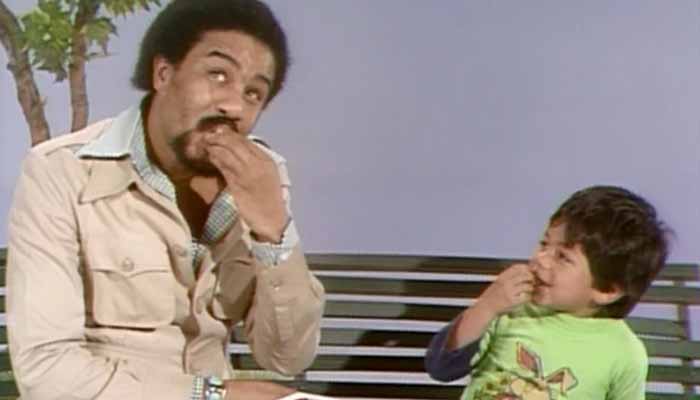
First up, the legendary Richard Pryor. In 1976, the groundbreaking, often profane “shock comedian,” known for his “racial epithets and all around vulgar humor” , graced Sesame Street to… teach the alphabet. Yes, you read that right. The sheer audacity is breathtaking. While he reportedly “kept it clean,” one can only imagine the nervous sweat pooling in the PBS control room. Flavorwire aptly noted, “it’s still hilarious — and you know that the crew must have been nervous”. His 1976 alphabet recital was delivered in his “own inimitable style” , a performance later described as a “rebellion against linguistic determinants,” where he imbued letters with “attitude, urban personality and irony,” making him the “antithesis of the conventional children’s television presenter”. This wasn’t just learning letters; it was an education in comedic tension. The decision to invite such a raw, boundary-pushing talent was a bold move, likely aimed at capturing the attention of adult viewers who knew Pryor for his decidedly non-kid-friendly material. The humor for those in the know came from the visible tightrope walk of a comedic genius trying to fit into a G-rated box.
Then there’s Ice-T. The original gangsta rapper, a man whose musical oeuvre includes the infamous “Cop Killer” and who is known for playing a “hard-bitten detective on a show about horrific crimes against women” , also took a trip to America’s friendliest street. Flavorwire described his delivery as “a little frightening. Earmuffs!”. Complex magazine didn’t hesitate to include him on their list of “Bad Seeds” who wouldn’t be invited back. While the exact year and full segment details are a bit hazy across sources, some suggest he participated in an alphabet song. The comedy here is pure juxtaposition: the hardcore image versus the fluffy, educational setting. One can almost hear him: “Today’s letter is ‘L,’ for ‘Listen up, Elmo, and learn!'”
And who could forget Cheech Marin? One half of the iconic stoner duo Cheech and Chong, a man whose very name became “slang for ‘incredibly high'”. It’s no surprise that, according to a 1994 Entertainment Weekly piece, “They resisted having me on the show for years,” likely due to his “drug lord connections” from their film personas. But by 1994, perhaps thanks to a kids’ album he’d released, the Street’s producers were convinced it was safe. Cheech appeared in a “turquoise blue Elvis suit,” looking like “Pakistani Elvis,” on a mission to convince Oscar the Grouch to share. His filmography also lists him as playing a “Genie” in Episode 3259 that year , and a YouTube transcript confirms an interaction with Oscar about sharing. The image of Cheech, even cleaned up, trying to impart life lessons to a trash-can dweller is inherently funny. These choices demonstrate an attempt by the show’s producers to stay culturally relevant and connect with parents, even if it meant tiptoeing through a minefield of potentially problematic associations. The fact that these performers often managed to tailor their acts for the young audience only adds to the humor, highlighting the effort involved in such a transformation.
The “Did No One Check a Mirror?” Catastrophes: Wardrobe Woes & Cleavage Calamities

Sometimes, it’s not the guest’s resume that raises eyebrows, but their ensemble. In the world of children’s television, a neckline can become an international incident, proving that even sunny days can be clouded by a wardrobe malfunction of judgment.
The undisputed champion of this category is Katy Perry. In 2010, the pop megastar filmed a duet with Elmo, a child-friendly rendition of her hit “Hot N Cold.” All seemed well until the segment was previewed on YouTube. Parents and commenters quickly zeroed in on Perry’s attire: a “Tinker Bell dress that is cut in a heart shape at the top revealing some cleavage”. Flavorwire didn’t pull any punches, stating her “cleavage was front and center” during the sketch.
The online feedback was swift and decisive. As Sesame Workshop themselves stated, “In light of the feedback we’ve received on the Katy Perry music video which was released on You Tube only, we have decided we will not air the segment on the television broadcast of Sesame Street”. Perry herself acknowledged the controversy with a tweet: “Wow, looks like my play date with Elmo has been cut short”. While some viewers defended the outfit as no more revealing than beachwear , the prevailing sentiment was that it was too risqué for preschoolers. The incident became a prime example of how online parental communities could directly influence broadcast decisions, even for an institution as established as Sesame Street. It also underscored the delicate line female pop stars navigate when trying to present a family-friendly image, especially when their broader public persona is often more provocative. Elmo just wanted to sing about temperature fluctuations, but the internet had a heated debate about fashion.
“Honey, I Don’t Think That Means What You Think It Means”: Adult Innuendo on Aisle 123
Ah, subtext. That delightful little gremlin that can turn an innocent children’s segment into something… else entirely, especially when the celebrity guest is primarily known for decidedly adult fare. These are the moments where the wink to the parents became a full-blown, slightly uncomfortable leer.
Take Kim Cattrall. Her appearance in 2008 to define the word “fabulous” for Abby Cadabby was, well, fabulous in its own awkward way. Given that Cattrall is overwhelmingly famous for playing the sexually adventurous Samantha Jones on Sex and the City, it was hard for adult viewers to separate the actress from the role. As Flavorwire noted, her enthusiastic delivery while discussing fairy wings felt “sort of uncomfortable” because it was “certainly related to her role as the sex maniac Samantha Jones”. Salon.com took it a step further, suggesting “it’s hard to watch this segment without any sexual innuendo,” even cheekily inserting “[sex]” into their interpretation of her definition: “Fabulous means when something [sex] is incredible. Marvelous. Or when it [sex] is really, really great (motions with hands)”. One imagines a collective, knowing smirk from parents across the nation, while their kids just wondered why the nice lady was so excited about glitter.
Then there was John Leguizamo as Captain Vegetable in a 2002 episode. Leguizamo, an actor and comedian celebrated for his edgy, often R-rated one-man shows and characters, donned a suit made of produce to extol the virtues of healthy eating. The truly head-scratching moment, as Flavorwire pointed out, came at the end of his segment with Elmo, when Captain Vegetable, our hero of horticulture, advised the little red monster: “zo Elmo remember you keep e vegetables ok player El than dat”. “Playa”? To Elmo? It was a linguistic choice so out of left field (or perhaps, left vegetable patch) that it was more bewildering than offensive, a perfect little nugget of unexpected street slang in a world of felt and fur. These instances highlight the challenge of Sesame Street’s dual-address strategy; sometimes the attempt to entertain adults can lead to moments where the subtext becomes the main text, creating a layer of humor (or discomfort) that sails right over kids’ heads but lands squarely with their parents.
The “Yikes, That Didn’t Age Well” Wing of the Sesame Street Museum
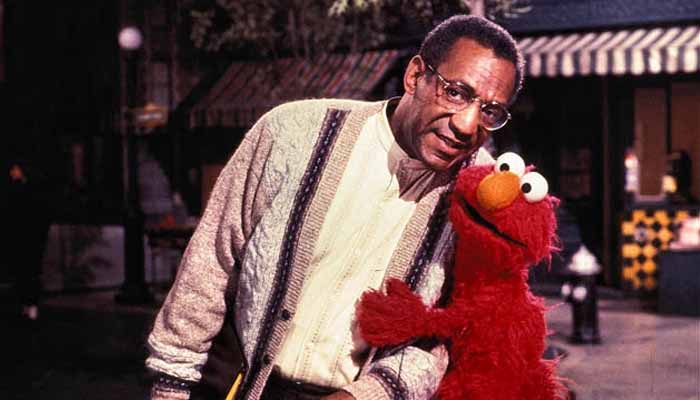
Step right up, folks, and don your hazmat suits of hindsight, because this section is dedicated to those guests whose later actions, scandals, or revelations cast a long, dark, and incredibly awkward shadow over their sunny day on the Street. These are the appearances that make you say, “Oof, if they only knew…”
Perhaps the most glaring and tragic example is Bill Cosby. Once “America’s Dad” and a frequent, beloved guest on Sesame Street in its early years (making some 12 appearances in the early 1970s, with Muppets even appearing on The Cosby Show ), his legacy is now irrevocably tainted by numerous accusations and a conviction for sexual assault. Watching old clips of him warmly interacting with Big Bird or Grover is now an exercise in profound discomfort. The contrast between the wholesome image he projected on the show and the horrific reality of his actions is a chilling reminder that public personas can be deeply deceptive.
Then there are other “Bad Seeds,” as Complex magazine dubbed them—guests who, for various reasons, wouldn’t be getting a return invitation. Mel Gibson, whose later anti-Semitic and racist tirades shocked the world, once shared the screen with Muppets. Chris Brown, whose conviction for domestic violence is public knowledge , also made an appearance. The irony of individuals later known for such destructive behavior teaching children about, presumably, kindness and respect is not lost on viewers today.
Alec Baldwin had a “cute cameo” in 2007, just a few short months before an infamous voicemail in which he verbally berated his 11-year-old daughter became public. This unfortunate timing retroactively adds a layer of unease to his otherwise innocuous appearance. The list goes on, with various other celebrities whose post-Sesame Street lives took controversial turns, from Kobe Bryant (facing a sexual assault allegation) to Tiki Barber (an adultery scandal) and Joe Namath (public struggles with alcohol). Sesame Street, in its long history, has inadvertently become an archive of “before they were infamous” moments. This isn’t the show’s fault, of course; producers aren’t psychic. But it does serve as a stark illustration of how celebrity images can shift and crumble, leaving behind a trail of awkward pop culture artifacts.
Straight-Up Bizarre: The Segments That Made Us Say “Huh?”
Forget scandal, forget innuendo. This category is reserved for those guest appearances and segments that were just… gloriously, unforgettably weird. These are the moments that make you tilt your head, squint a little, and wonder about the creative process that led to this particular piece of television.
Leading the charge is James Earl Jones in 1969. As Sesame Street’s very first celebrity guest, he delivered a rendition of the alphabet and counted to ten that was, by many accounts, less “educational” and more “mildly terrifying.” With a “close-up of Jones’ shiny, bald head,” he recited in an “intense, booming voice”. Mental Floss described it as “truly terrifying to the toddlers in the audience”. Upworthy called his ABCs “plodding or bizarrely hypnotic,” his voice “boom[ing] the letter names ominously”. Perhaps it was method acting for his future role as Darth Vader? “A… B… C… Join the dark side, Elmo.”
Then there was Jamie Foxx, whose appearance left Flavorwire asking if his “R&B version of The Nutcracker with Foxx as a toy” was “genius? Or just nuts?”. The sheer randomness of the concept is what makes it a gem of delightful oddity. One imagines the pitch meeting: “Okay, so it’s The Nutcracker, but with more soul, and Jamie Foxx is… a doll. Trust us, the kids will love it!”
Not to be outdone in the “wait, what?” department, Robert De Niro stopped by to explain to Elmo what an actor does. His method? Barking like a dog, pretending to be a cabbage, and then transforming into Elmo himself. Parade.com called the sight of the “normally shy DeNiro” engaging in such antics “Priceless!”. It’s a performance that truly makes you say, “You talkin’ to me? No, I’m a cruciferous vegetable now.”
Consumer advocate Ralph Nader‘s 1988 visit was a masterclass in unexpected television. He sang “A Consumer Advocate is a person in your neighborhood,” then, in a stunning display of his principles, inspected Bob’s sweater for “shoddy workmanship” and promptly destroyed it. As if that weren’t enough, he also initially “refused to sing the song unless the lyrics were changed from ‘the people that you meet’ to the more grammatically correct ‘the people whom you meet'”. Today’s lesson, kids: proper grammar, and never let a man with strong opinions on syntax near your knitwear.
Broadcasting legend Larry King also made an appearance, interviewing the letter “W.” Flavorwire suggested kids might be “sort of afraid of — either that or bored” by him, making him an “odd choice” considering the target demographic likely had no clue who he was, despite his interview being “completely marvelous”.
Judah Friedlander, known for his “stoner-slacker character on 30 Rock” , was another “weird choice.” He popped up around 2010 to discuss the word “spectacular” and also appeared as “Inspector 4,” a character obsessed with finding items in groups of four. Kids love doofy dudes with trucker hats, apparently.
The architect of rock and roll, Little Richard, brought his signature flamboyant style to the Street in 1994, delivering a high-energy, rock-and-roll rendition of “Rubber Duckie”. While “crazy” might be too strong a word for just being Little Richard, his performance was certainly a departure from Ernie’s gentle bathtub ballad. “Womp-bomp-a-loo-mop, a-wop-bam-BOOM, Rubber Duckie, you’re the one!”
And in a truly surreal moment from 2002, James Gandolfini—yes, Tony Soprano himself—sat down with Zoe to discuss his fears. These included being afraid of the dark (for which he uses a nightlight and a teddy bear), getting haircuts (the barber gives him a lollipop, which helps), and, most memorably, “giant talking vegetables”. The sight of this formidable actor, known for playing one of television’s most iconic tough guys, earnestly sharing his childhood anxieties with a Muppet is the kind of bizarre that borders on brilliant. These moments, born from a desire to educate and entertain, sometimes veered into the wonderfully weird, creating unforgettable television precisely because of their strangeness.
The “Too Hot (or Too Offensive) for TV” Club: Banned from the Street!
While Sesame Street has always pushed boundaries in children’s education, sometimes those boundaries pushed back. This section is for the segments that crossed a line, at least in the eyes of concerned parents, advocacy groups, or network censors, leading to them being pulled from the airwaves or sparking significant controversy.
We’ve already discussed the Katy Perry cleavage-gate of 2010, where her “Hot N Cold” duet with Elmo was famously yanked from the TV broadcast schedule after its online preview caused a stir over her revealing outfit. This stands as a prime example of public outcry in the digital age directly impacting programming.
Then there’s the case of John Candy as Yosh Shmenge. The beloved Canadian comedian appeared as his popular SCTV character, a polka-loving clarinet player. However, one particular segment featuring Yosh was “pulled after its initial airing due to complaints from Polish groups”. While the specifics of the complaints or the exact content of the offending segment aren’t fully detailed in the available information, the fact that it was censored is notable. Candy did appear as Shmenge in other Sesame Street contexts, such as the “Sesame Street, Special” in 1988 and “Sesame Street: Sing Yourself Silly!” , suggesting the issue was with a specific portrayal rather than the character itself.
And while not a celebrity guest causing the controversy, the show’s handling of Mr. Hooper’s death in 1983 was a landmark moment that initially faced some headwinds. When actor Will Lee passed away, Sesame Street made the bold decision to address death directly and honestly with its young audience. The creative team was reportedly “nervous” about the episode, and it “did receive some criticism for discussing death”. However, it was ultimately “received positively” and is now considered a milestone in children’s television for its sensitive and groundbreaking approach to a difficult subject. This instance shows that even when tackling serious topics with the best intentions, the show sometimes had to navigate initial discomfort or disagreement from its audience. These episodes highlight the delicate tightrope Sesame Street often walks, balancing creative choices with the diverse sensitivities of its viewers.
(Alleged) Musical Mayhem: Did Telly Really Meet an Axe?

Now, we venture into the wilder, woollier, and possibly apocryphal side of Sesame Street guest lore. The claims here are so outlandish, so utterly bonkers, that they must be shared, albeit with a hefty dose of “according to the internet” skepticism. The primary source for these particular shockers is a transcript from a YouTube video , and without further corroboration from the provided materials, we’re treating these as the stuff of playground legend.
First up, the Insane Clown Posse (ICP). Yes, that ICP. According to the aforementioned YouTube transcript, “parents and children were horrified by the duo’s musical performance of My Axe in which Telly Monster was seemingly hacked to death off camera… a class action lawsuit was brought against PBS and ICP for emotional trauma suffered by at least 100 children however the case was settled out of court and the episode has never aired since”. Hold the phone. Telly? An axe? Violent J and Shaggy 2 Dope on Sesame Street? This sounds less like a children’s educational segment and more like a fever dream cooked up in a dark corner of the web. The lack of widespread news reports or official PBS statements about such a traumatic event (beyond this single YouTube source in the provided materials ) makes this claim highly suspect, but as a piece of “worst guest” folklore, it’s too spectacularly weird to ignore.
And if that wasn’t enough, the same YouTube source alleges that the heavy metal band Slipknot made an appearance in 2010. Their supposed performance, an adaptation of their song “The Devil and I,” allegedly “drew complaints not only for the content of the song but also because children were reportedly frightened by the band’s masks and makeup pbs apologized that the segment was in poor taste and at least three employees of the show were fired over the incident”. Again, the imagery is jarring: nine masked metallers teaching kids their numbers? While the idea of children being frightened by Slipknot’s masks is plausible, the notion of them performing such a song on Sesame Street, leading to firings, strains credulity without more substantial evidence. These stories, whether containing a kernel of truth or being entirely fabricated, highlight how extreme rumors can attach themselves to even the most wholesome of cultural icons. The more innocent the institution, the more shocking (and shareable) the “dark secret” becomes.
The Sesame Street “Guest Star Gamble” Scorecard
To help you keep track of some of the most memorably misguided moments, here’s a handy (and highly subjective) scorecard:
| Guest Star | Approx. Year | Known For (Pre-Street Cred) | The Sesame Street Stunt | Awkward-O-Meter Reading (1-10 Grouches) | Why We’re Still Talking About It |
|---|---|---|---|---|---|
| Richard Pryor | 1976 | Profane, groundbreaking stand-up comedy | Teaching the ABCs with palpable tension | 9 Grouches | The sheer audacity of it all. |
| Katy Perry | 2010 | Pop megastar, sometimes risqué outfits | “Hot N Cold” duet with Elmo; outfit deemed too revealing | 7 Grouches | Cleavage-gate! Pulled from broadcast. |
| Ice-T | Early 90s? | Gangsta rap pioneer, “Cop Killer” controversy | Alphabet songs with a “frightening” delivery | 8 Grouches | “Original Gangster” meets Original Muppets. |
| Kim Cattrall | 2008 | Samantha Jones from Sex and the City | Defining “fabulous” for Abby Cadabby with… implications | 7.5 Grouches | The subtext was louder than Elmo’s giggles. |
| James Earl Jones | 1969 | Respected actor (pre-Darth Vader fame) | “Terrifying” booming alphabet recital with intense close-up | 6 Grouches (for the kids) | The original bizarre celebrity cameo. |
| Robert De Niro | ~Late 90s | Legendary dramatic actor | Explained “actor” by becoming a dog, a cabbage, and Elmo | 8 Grouches | “You talkin’ to me? Or the broccoli?” |
| John Candy | ~1980s | Beloved comedic actor (SCTV’s Yosh Shmenge) | Yosh Shmenge segment pulled after complaints from Polish groups | 5 Grouches (for the controversy) | The mystery of the banned polka. |
| Insane Clown Posse | Alleged | Shock-rock/horrorcore rap duo | Allegedly performed “My Axe” as Telly was “hacked to death” off-camera | 11 Grouches (if true!) | The wildest, most unbelievable Sesame Street urban legend. |
Conclusion: Our Favorite Street, Flaws and All (Plus, Who NOT to Invite Next)
So, there you have it: a whirlwind tour through some of Sesame Street’s most eyebrow-raising, side-splittingly awkward, and occasionally downright bizarre celebrity guest appearances. Does this litany of questionable choices tarnish the legacy of our beloved Street? Not a chance. If anything, it adds a layer of wonderfully human (and often hilarious) imperfection to a show that has, for over five decades, strived to educate, entertain, and enlighten.
The truth is, staying relevant and engaging for generations means taking risks. Sometimes those risks lead to Emmy awards and groundbreaking educational content. And sometimes, well, sometimes they lead to articles like this one. These moments, these “worst” guests, are the exceptions that prove the rule – the rule being that Sesame Street, at its core, has always been a force for good, with a spirit and intention that remain true to its original goals. The ability to look back and laugh at these occasional missteps, without diminishing our affection for the show, speaks volumes about the deep cultural goodwill it has cultivated.
If the current producers are reading this (hey, you never know!), perhaps some gentle casting advice for the future:
- If a potential guest’s most famous song lyric involves a weapon or a detailed description of a crime, maybe sleep on it.
- A quick Google image search for “Guest Name + Red Carpet” might save some wardrobe-related headaches.
- If the crew seems “nervous” before filming, that might be a tiny red flag. Or a giant, felt-covered one.
Ultimately, these hilariously awkward moments are part of Sesame Street’s rich tapestry. They remind us that even on the sunniest of streets, things can get a little weird – and that, in itself, can be pretty entertaining.
Now, over to you: Who did we miss? What’s your personal favorite “worst” Sesame Street guest moment that still makes you chuckle (or cringe) to this day? Let us know in the comments – just try to keep it G-rated… mostly.

